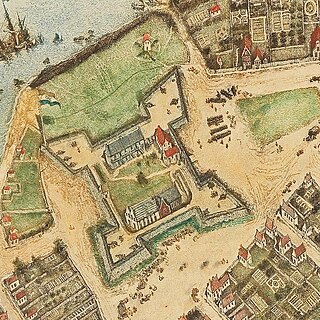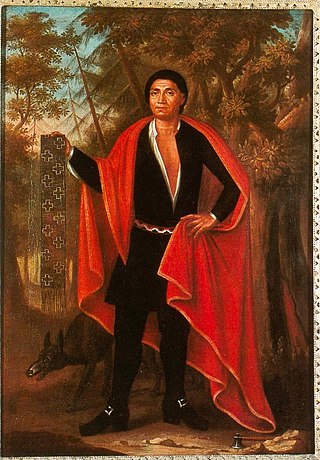Related Research Articles

Giovanni Battista Beccaria was an Italian physicist. A fellow of the Royal Society, he published several papers on electrical subjects in the Phil. Trans. Beccaria was one of Benjamin Franklin's more conspicuous correspondents. His students included Joseph-Louis Lagrange, Giovanni Francesco Cigna, Giuseppe Angelo Saluzzo, and the successor to the Chair of physics, Antonio Vassalli Eandi; moreover, his researches inspired the physicists of Pavia, Alessandro Volta and Luigi Galvani.
This article contains information about the literary events and publications of 1727.

Fort Amsterdam was a fortification on the southern tip of Manhattan Island at the confluence of the Hudson and East rivers. The fort and the island were the center of trade and the administrative headquarters for the Dutch and then British/Colonial rule of the colony, of New Netherland and thereafter the Province of New York. The fort was the nucleus of the settlement on the island and greater area, which was named New Amsterdam by the first Dutch settlers, and eventually renamed New York by the English, and was central to much of New York's early history.

Events from the year 1746 in Canada.

The American Enlightenment was a period of intellectual and philosophical fervor in the thirteen American colonies in the 18th to 19th century, which led to the American Revolution and the creation of the United States of America. The American Enlightenment was influenced by the 17th- and 18th-century Age of Enlightenment in Europe and native American philosophy. According to James MacGregor Burns, the spirit of the American Enlightenment was to give Enlightenment ideals a practical, useful form in the life of the nation and its people.
The Covenant Chain was a series of alliances and treaties developed during the seventeenth century, primarily between the Iroquois Confederacy (Haudenosaunee) and the British colonies of North America, with other Native American tribes added. First met in the New York area at a time of violence and social instability for the colonies and Native Americans, the English and Iroquois councils and subsequent treaties were based on supporting peace and stability to preserve trade. They addressed issues of colonial settlement, and tried to suppress violence between the colonists and Indian tribes, as well as among the tribes, from New England to the Colony of Virginia.

Hendrick Theyanoguin, whose name had several spelling variations, was a Mohawk leader and member of the Bear Clan. He resided at Canajoharie or the Upper Mohawk Castle in colonial New York. He was a Speaker for the Mohawk Council. Hendrick formed a close alliance with Sir William Johnson, the Superintendent of Indian affairs in North America.

Cadwallader Colden was a physician, natural scientist, a lieutenant governor and acting Governor for the Province of New York.

Cadwallader David Colden was an American politician who served as the 54th Mayor of New York City and a U.S. Representative from New York.
Jane Colden was an American botanist, described as the "first botanist of her sex in her country" by Asa Gray in 1843. Although not acknowledged in contemporary botanical publications, she wrote a number of letters resulting in botanist John Ellis writing to Carl Linnaeus of her work applying the Linnaean system of plant identification to American flora, for which botanist Peter Collinson stated "she deserves to be celebrated". Contemporary scholarship maintains that she was the first female botanist working in America, which ignores, among others, Maria Sibylla Merian or Catherine Jérémie. Colden was respected as a botanist by many prominent botanists including John Bartram, Peter Collinson, Alexander Garden, and Carl Linnaeus. Colden is most famous for her untitled manuscript, housed in the British Museum, in which she describes the flora of the Hudson Valley in the Newburgh region of New York state, including ink drawings of 340 different species.
This bibliography of George Washington is a selected list of written and published works about George Washington (1732–1799). A recent count has estimated the number of books about George Washington at some nine hundred; add scholarly articles with Washington's name in the title and the count climbs to six thousand.

The Iroquois, also known as the Five Nations or the Six Nations and by the endonym Haudenosaunee, are an Iroquoian-speaking confederacy of Native Americans and First Nations peoples in northeast North America and Upstate New York. They were known during the colonial years to the French as the "Iroquois League", and later as the "Iroquois Confederacy". The English called them the "Five Nations", including the Mohawk, Oneida, Onondaga, Cayuga, and Seneca. After 1722, the Iroquoian-speaking Tuscarora from the southeast were accepted into the confederacy, which became known as the Six Nations.

The 1821 United States House of Representatives elections in New York were held from April 24 to 26, 1821, to elect 27 U.S. Representatives to represent the State of New York in the United States House of Representatives of the 17th United States Congress.

Hendrick Tejonihokarawa, also known as Tee Yee Neen Ho Ga Row and Hendrick Peters was a pro-English leader of the Mohawk in the Province of New York in the early 18th century. He was one of the "Four Mohawk Kings" who went to London in 1710 to meet with Queen Anne of Great Britain and her court to mark a treaty with her. The chiefs requested the Queen's help in controlling French influence in New York and asked for English missionaries to help their people offset French Catholic influence. The Mohawk diplomacy helped the Iroquois preserve their power through the colonial years.
Zachariah Hood was an Annapolis businessman who in 1765 was given the job of stamp collector for the Province of Maryland, collecting the duty payable under the new Stamp Act. Returning to Maryland from England in August 1765, he was attacked by an angry mob, and was forced to flee to New York for his life, in what may have been the first forcible resistance in America to British taxation in the years preceding the American Revolution. Hood returned to Maryland but, finding himself persona non grata, he left for the West Indies. In 1774 he was appointed comptroller of the Port of Philadelphia, but he fared little better and in May 1775 he was forced again to flee, this time to England, where he was granted a salary by Prime Minister Lord North.

The Battle of Sorel occurred on June 19, 1610, with Samuel de Champlain supported by the Kingdom of France and his allies, the Huron, Algonquin people, and Montagnais that fought against the Mohawk people in New France at present-day Sorel-Tracy, Quebec. The forces of Champlain armed with the arquebus engaged and killed or captured nearly all of the Mohawks. The battle ended major hostilities with the Mohawks for twenty years.
Henrietta Marie Bethune Colden (1745–1800) was a Scottish salon holder from Isle of Man.
Eric A. Hinderaker is an American historian specializing in early America.
As of 2018, several firms in the United States rank among the world's biggest publishers of books in terms of revenue: Cengage Learning, HarperCollins, Houghton Mifflin Harcourt, McGraw-Hill Education, Scholastic, Simon & Schuster, and Wiley.
Alexander Colden was an American merchant and public official in Colonial New York who was the son of Cadwallader Colden.
References
- ↑ Richter, Daniel K. (2001). Facing East from Indian Country: A Native History of Early America . Harvard University Press. p. 167. hdl:2027/heb.03491. ISBN 978-0-674-00638-6. OCLC 1034669832.
- 1 2 Wroth 1969, p. 91.
- ↑ Colden 2017, pp. ix, xxiii.
- ↑ Hinderaker 2011, p. 142.
- ↑ Olsen-Harbich, Peter (July 2018). "The History of the Five Indian Nations Depending on the Province of New-York in America: A Critical Edition". Ethnohistory . 65 (3): 533–534. doi:10.1215/00141801-4451584. ISSN 0014-1801. S2CID 166196046.